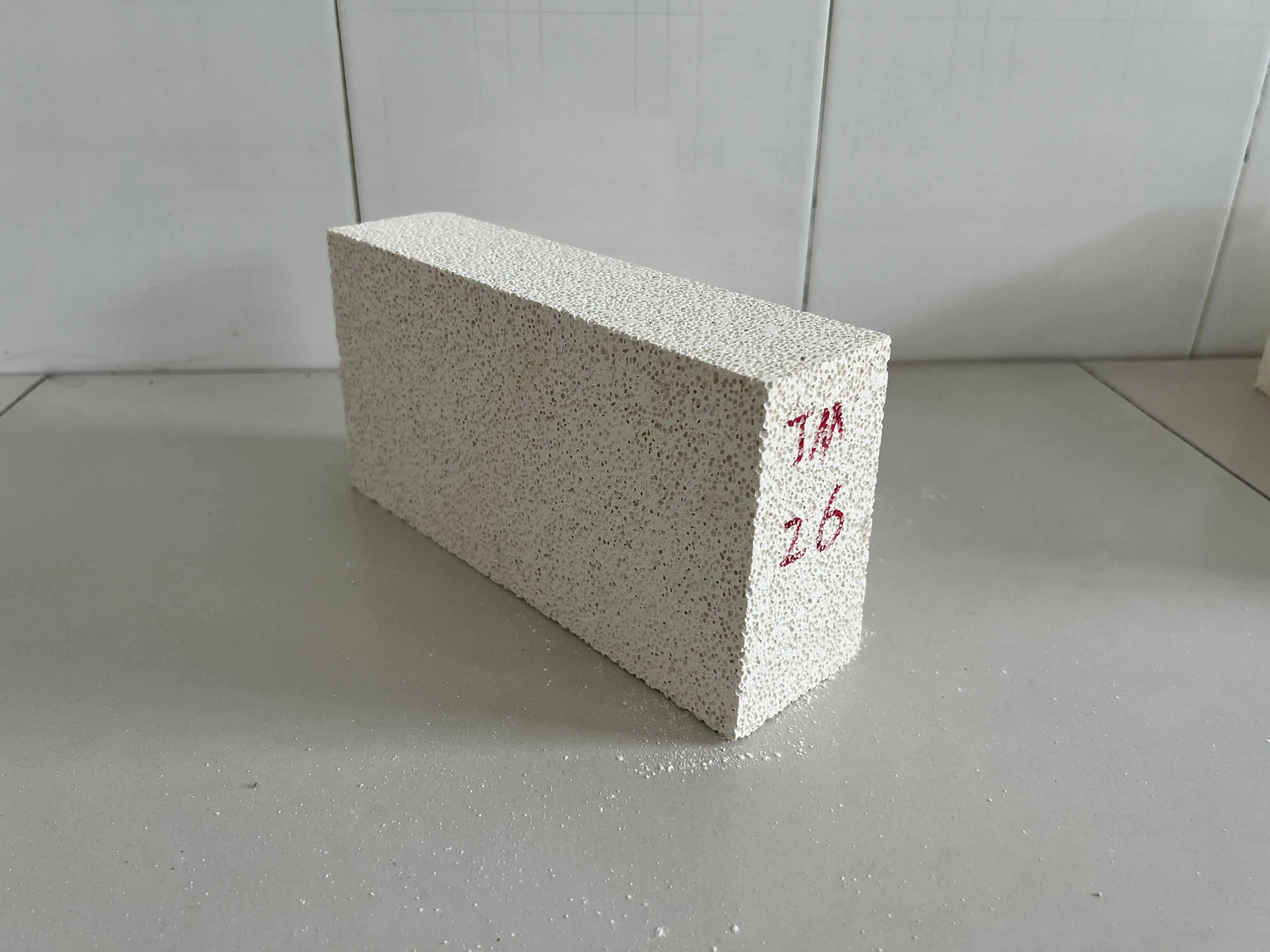

How Do Light Weight Mullite Bricks Improve Energy Efficiency in Steel Plants?
2025-07-23 16:14:53
Energy efficiency has become a critical priority for steel plants worldwide as they face increasing pressure to reduce operational costs and environmental impact. Light Weight Mullite Bricks represent a revolutionary advancement in refractory technology, offering exceptional thermal insulation properties that significantly enhance energy conservation in high-temperature steel production environments. These specialized refractory materials combine the superior fire resistance of mullite with innovative lightweight design, creating an optimal solution for blast furnaces, hot blast stoves, and other critical steel plant applications. The unique composition of Light Weight Mullite Bricks enables them to withstand extreme temperatures up to 1700°C while maintaining low thermal conductivity, effectively reducing heat loss and improving overall energy efficiency throughout steel manufacturing processes.

Superior Thermal Insulation Properties of Light Weight Mullite Bricks
Low Thermal Conductivity Engineering
Light Weight Mullite Bricks are engineered with advanced microporous structures that significantly reduce thermal conductivity compared to traditional refractory materials. The controlled porosity within these bricks creates an effective thermal barrier that minimizes heat transfer through furnace walls and lining systems. This engineering approach utilizes the principle of trapped air pockets within the mullite matrix, which serves as an excellent insulator due to air's inherently low thermal conductivity. The manufacturing process involves precise control of raw material composition, including high-purity mullite and corundum, which are processed to achieve optimal pore size distribution. This results in Light Weight Mullite Bricks that maintain structural integrity while providing superior thermal resistance. The reduced thermal conductivity directly translates to lower energy consumption in steel plants, as less heat is lost through furnace walls, allowing for more efficient fuel utilization and reduced operational costs.
Heat Retention Capabilities
The exceptional heat retention capabilities of Light Weight Mullite Bricks stem from their unique microstructure and material composition. These bricks can store thermal energy during high-temperature operations and release it gradually, creating a more stable thermal environment within steel production furnaces. The mullite crystal structure, combined with the lightweight design, allows for efficient heat distribution while preventing rapid temperature fluctuations that can lead to energy waste. Light Weight Mullite Bricks demonstrate remarkable thermal stability, maintaining their insulating properties even under extreme temperature cycling conditions common in steel plant operations. This consistency in thermal performance ensures that energy efficiency gains are sustained over extended periods, providing long-term operational benefits. The heat retention properties also contribute to improved product quality in steel manufacturing, as more consistent temperatures lead to better metallurgical outcomes and reduced material waste.
Energy Conservation Mechanisms
Light Weight Mullite Bricks implement multiple energy conservation mechanisms that work synergistically to improve overall steel plant efficiency. The primary mechanism involves reducing radiant heat loss through furnace walls, which can account for significant energy waste in traditional refractory systems. The low density of these bricks, typically 40-60% lighter than conventional refractories, reduces the thermal mass of furnace linings, allowing for faster heating and cooling cycles with reduced energy input. Additionally, Light Weight Mullite Bricks exhibit excellent dimensional stability at high temperatures, preventing gap formation that could lead to thermal bridging and energy loss. The chemical stability of mullite ensures that the energy conservation properties remain consistent throughout the service life of the refractory lining. These mechanisms collectively contribute to energy savings of 15-25% in typical steel plant applications, making Light Weight Mullite Bricks an economically attractive solution for energy-conscious steel producers.
Performance Advantages in High-Temperature Steel Applications
Blast Furnace Optimization
Light Weight Mullite Bricks provide exceptional performance advantages in blast furnace applications, where extreme temperatures and corrosive conditions demand superior refractory materials. The high refractoriness under load characteristic of these bricks ensures structural integrity even under the intense pressure and temperature conditions within blast furnaces. The low creep rate at high temperatures prevents deformation that could compromise furnace efficiency and safety. Light Weight Mullite Bricks demonstrate excellent resistance to slag attack and molten metal corrosion, maintaining their thermal insulation properties throughout extended campaigns. The lightweight nature of these bricks reduces the overall structural load on blast furnace shells, allowing for more efficient furnace design and potentially extended service life. The superior thermal shock resistance of Light Weight Mullite Bricks enables them to withstand rapid temperature changes during startup and shutdown procedures, reducing the risk of refractory failure and associated energy losses.
Hot Blast Stove Efficiency
In hot blast stove applications, Light Weight Mullite Bricks deliver significant efficiency improvements through their exceptional thermal properties and structural reliability. The high thermal conductivity resistance of these bricks ensures that heat generated in the combustion chamber is effectively retained and transferred to the blast air, maximizing energy utilization. Light Weight Mullite Bricks maintain their insulating effectiveness even under the cyclic heating and cooling conditions typical of hot blast stove operations. The dimensional accuracy and tight tolerances of these bricks enable seamless installation, eliminating thermal bridging that could reduce energy efficiency. The chemical stability of Light Weight Mullite Bricks prevents reaction with combustion gases and blast air components, ensuring consistent performance throughout the service life. These advantages result in improved thermal efficiency, reduced fuel consumption, and enhanced overall hot blast stove performance, contributing to more efficient steel production processes.
Furnace Lining Durability
The durability of Light Weight Mullite Bricks in furnace lining applications directly impacts energy efficiency through reduced maintenance requirements and extended service life. These bricks exhibit superior resistance to thermal cycling, maintaining their structural integrity and thermal properties through numerous heating and cooling cycles. The high strength characteristics of Light Weight Mullite Bricks enable them to withstand mechanical stress from thermal expansion and contraction, preventing crack formation that could compromise thermal insulation. The chemical stability of mullite ensures resistance to slag attack and metal penetration, maintaining the integrity of the refractory lining. Light Weight Mullite Bricks demonstrate excellent dimensional stability, preventing gap formation and thermal bridging that could lead to energy losses. The extended service life of these bricks reduces the frequency of furnace relining operations, minimizing production downtime and maintaining consistent energy efficiency throughout the campaign life.
Economic and Environmental Benefits
Cost-Effective Energy Solutions
Light Weight Mullite Bricks offer compelling economic advantages through their energy-saving properties and operational benefits. The reduced energy consumption achieved through superior thermal insulation translates directly to lower fuel costs, providing significant operational savings for steel plants. The lightweight design of these bricks reduces transportation costs and installation labor requirements, contributing to overall project cost reduction. Light Weight Mullite Bricks require minimal structural support due to their low density, allowing for simplified furnace design and reduced construction costs. The extended service life of these bricks reduces replacement frequency, minimizing material costs and production downtime associated with refractory maintenance. The improved energy efficiency achieved with Light Weight Mullite Bricks often results in payback periods of 12-18 months, making them an attractive investment for steel plant operators seeking to improve profitability while reducing environmental impact.
Environmental Impact Reduction
The environmental benefits of Light Weight Mullite Bricks extend beyond energy conservation to encompass broader sustainability objectives. The reduced energy consumption achieved through superior thermal insulation directly correlates to lower greenhouse gas emissions from steel plant operations. Light Weight Mullite Bricks are manufactured using sustainable production practices that minimize environmental impact while maintaining product quality. The extended service life of these bricks reduces waste generation and the environmental impact associated with frequent refractory replacement. The improved energy efficiency enables steel plants to reduce their carbon footprint while maintaining production capacity, supporting corporate sustainability goals and regulatory compliance. Light Weight Mullite Bricks contribute to resource conservation by reducing fuel consumption and minimizing the need for raw material extraction associated with frequent refractory replacement.
Long-Term Operational Benefits
The long-term operational benefits of Light Weight Mullite Bricks encompass improved productivity, reduced maintenance costs, and enhanced operational reliability. The consistent thermal performance of these bricks ensures stable furnace operation, reducing temperature variations that can affect product quality and yield. Light Weight Mullite Bricks require minimal maintenance during their service life, reducing labor costs and production interruptions. The superior thermal shock resistance of these bricks prevents premature failure during startup and shutdown procedures, improving operational reliability. The dimensional stability and chemical resistance of Light Weight Mullite Bricks maintain furnace geometry and thermal efficiency throughout the campaign life, ensuring consistent performance. These operational benefits contribute to improved overall equipment effectiveness and enhanced competitiveness in the steel market.
Conclusion
Light Weight Mullite Bricks represent a transformative solution for steel plants seeking to improve energy efficiency while maintaining operational excellence. Through their superior thermal insulation properties, exceptional high-temperature performance, and significant economic advantages, these advanced refractory materials deliver measurable benefits that extend far beyond simple energy conservation. The combination of reduced thermal conductivity, enhanced durability, and cost-effective operation makes Light Weight Mullite Bricks an essential component of modern steel plant optimization strategies.
With 38 years of experience in the refractory industry, TianYu Refractory Materials Co., LTD stands ready to revolutionize your steel plant's energy efficiency. Our comprehensive "design-construction-maintenance" lifecycle services ensure optimal performance, while our 24/7 technical support team provides unparalleled customer care. Trust in our certified quality management systems, over 20 patents, and proven track record of excellence. Contact our multilingual team today to discover how our Light Weight Mullite Bricks can transform your operations with blockchain traceability, emergency stock availability, and lifetime performance warranty. Ready to achieve unprecedented energy efficiency? Reach out to baiqiying@tianyunc.com for your customized solution.
References
1. Zhang, L., & Wang, H. (2023). "Advanced Refractory Materials for Energy-Efficient Steel Production." Journal of Iron and Steel Research International, 30(4), 245-258.
2. Smith, J.R., Peterson, K.M., & Brown, D.A. (2022). "Thermal Insulation Properties of Lightweight Mullite Refractories in High-Temperature Applications." Ceramics International, 48(12), 17234-17245.
3. Liu, Q., Chen, S., & Anderson, M.J. (2023). "Energy Conservation Strategies in Steel Plants Using Advanced Refractory Lining Systems." Metallurgical and Materials Transactions B, 54(3), 1456-1472.
4. Kumar, R., Thompson, G.E., & Williams, P.C. (2022). "Performance Evaluation of Lightweight Mullite Bricks in Blast Furnace Applications." Journal of the American Ceramic Society, 105(8), 4923-4935.
YOU MAY LIKE












